Serving 513 students in grades Prekindergarten-5, J. D. Parker School Of Technology ranks in the bottom 50% of all schools in Florida for overall test scores (math proficiency is bottom 50%, and reading proficiency is bottom 50%).
The percentage of students achieving proficiency in math is 43% (which is lower than the Florida state average of 52%). The percentage of students achieving proficiency in reading/language arts is 41% (which is lower than the Florida state average of 52%).
The student:teacher ratio of 16:1 is lower than the Florida state level of 17:1.
Minority enrollment is 79% of the student body (majority Hispanic), which is higher than the Florida state average of 65% (majority Hispanic).
Quick Stats (2025)
- Grades: Prekindergarten-5
- Enrollment: 513 students
- Student:Teacher Ratio: 16:1
- Minority Enrollment: 79%
- Overall Testing Rank: Bottom 50% in FL
- Math Proficiency: 43% (Btm 50%)
- Reading Proficiency: 41% (Btm 50%)
- Science Proficiency: 30-34% (Btm 50%)
- Source: National Center for Education Statistics (NCES), FL Dept. of Education
Top Rankings
J. D. Parker School Of Technology ranks among the top 20% of public schools in Florida for:
Category
Attribute
Diversity
Student Attention
School Overview
J. D. Parker School Of Technology's student population of 513 students has declined by 19% over five school years.
The teacher population of 33 teachers has declined by 23% over five school years.
Grades Offered
Grades Prekindergarten-5
Total Students
513 students
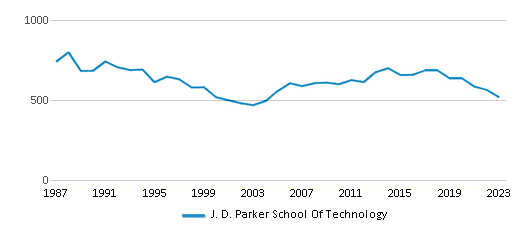
Gender %
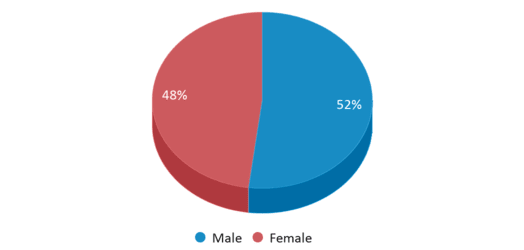
Total Classroom Teachers
33 teachers

Students by Grade

School Calendar
School Rankings
J. D. Parker School Of Technology ranks within the bottom 50% of all 3,704 schools in Florida (based off of combined math and reading proficiency testing data).
The diversity score of J. D. Parker School Of Technology is 0.68, which is less than the diversity score at state average of 0.70. The school's diversity has stayed relatively flat over five school years.
Overall Testing Rank
#2478 out of 3704 schools
(Bottom 50%)
(Bottom 50%)
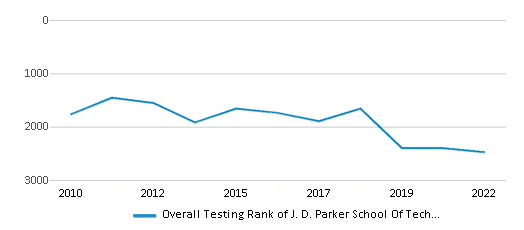
Math Test Scores (% Proficient)
43%
52%
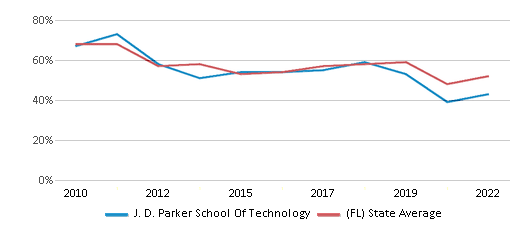
Reading/Language Arts Test Scores (% Proficient)
41%
52%
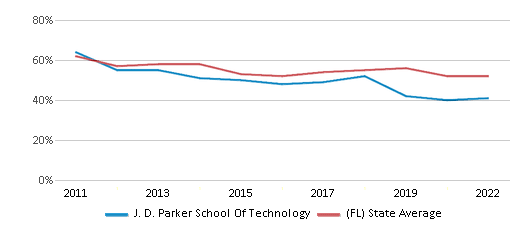
Science Test Scores (% Proficient)
30-34%
52%
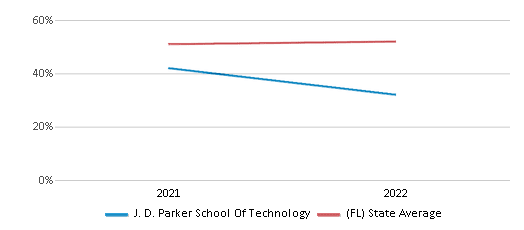
Student : Teacher Ratio
16:1
17:1
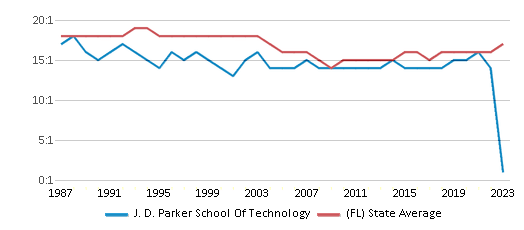
American Indian
n/a
n/a
Asian
2%
3%
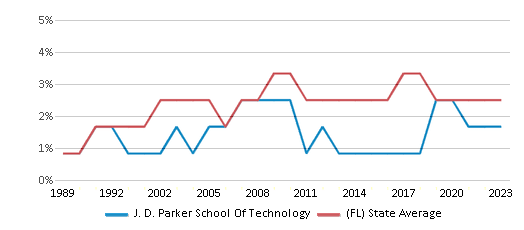
Hispanic
47%
37%

Black
23%
21%
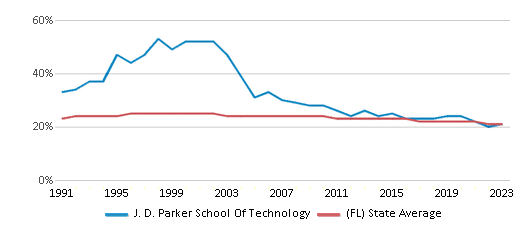
White
21%
35%
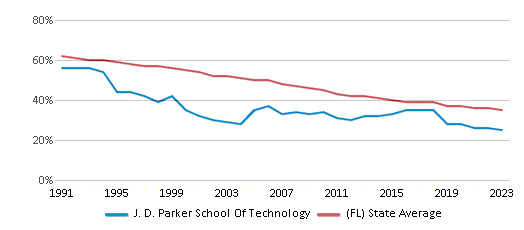
Hawaiian
n/a
n/a
Two or more races
7%
4%

All Ethnic Groups
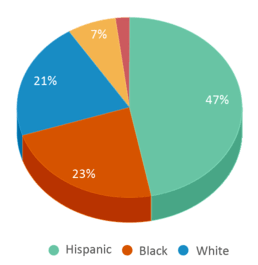
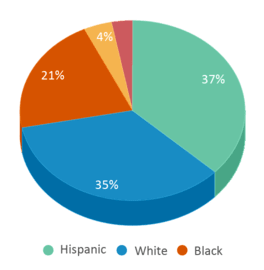
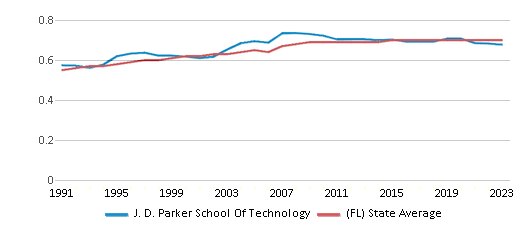
Participates in the National School Lunch Program (NSLP)
Yes
Eligible for Free Lunch
65%
47%
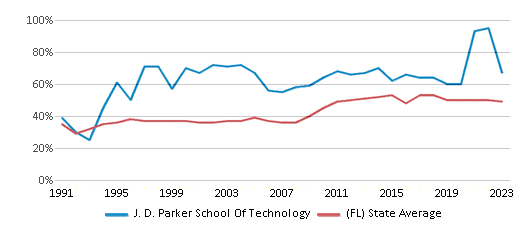
Eligible for Reduced Lunch
5%
4%
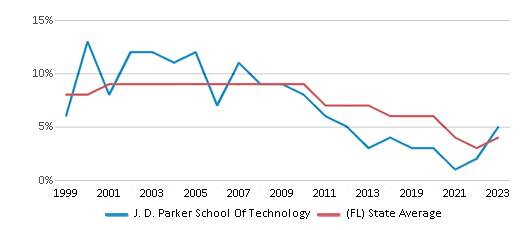
School Statewide Testing
School District Name
Source: National Center for Education Statistics (NCES), FL Dept. of Education
Frequently Asked Questions
What is J. D. Parker School Of Technology's ranking?
J. D. Parker School Of Technology is ranked #2478 out of 3,704 schools, which ranks it among the bottom 50% of public schools in Florida.
What schools are J. D. Parker School Of Technology often compared to?
J. D. Parker School Of Technologyis often viewed alongside schools like Palm City Elementary School, Bessey Creek Elementary School, Pinewood Elementary School by visitors of our site.
What percent of students have achieved state testing proficiency in math and reading?
43% of students have achieved math proficiency (compared to the 52% FL state average), while 41% of students have achieved reading proficiency (compared to the 52% FL state average).
How many students attend J. D. Parker School Of Technology?
513 students attend J. D. Parker School Of Technology.
What is the racial composition of the student body?
47% of J. D. Parker School Of Technology students are Hispanic, 23% of students are Black, 21% of students are White, 7% of students are Two or more races, and 2% of students are Asian.
What is the student:teacher ratio of J. D. Parker School Of Technology?
J. D. Parker School Of Technology has a student ration of 16:1, which is lower than the Florida state average of 17:1.
What grades does J. D. Parker School Of Technology offer ?
J. D. Parker School Of Technology offers enrollment in grades Prekindergarten-5
What school district is J. D. Parker School Of Technology part of?
J. D. Parker School Of Technology is part of Martin School District.
School Reviews
5 8/5/2021
Teachers and admin are absolutely wonderful! I am so glad my son switched to this school! He is thriving academically and enjoying being challenged in an enriched environment. We love JDP!
2 1/6/2020
JD Parker has some great teachers! Administration and their support teams, not so good. They don't follow through; they shift blame. Are slow to recognize disabilities or do not have the insight to support the parent with consistency in school.Parental and school communications are poor. Scapegoating seems to be overused at the expense of the student and the parent. A lot of the programs set up by JD Parker are helpful to the less fortunate. I would say one of their strongest attributes. Their teachers’ devotion to the student, and a genuine caring, again one of the stronger attributes.
Review J. D. Parker School Of Technology. Reviews should be a few sentences in length. Please include any comments on:
- Quality of academic programs, teachers, and facilities
- Availability of music, art, sports and other extracurricular activities
Recent Articles

What Is A Charter School?
Explore the world of charter schools in this comprehensive guide. Learn about their history, how they operate, and the pros and cons of this educational innovation. Discover key facts about charter schools, including admission policies, demographics, and funding, as well as what to look for when considering a charter school for your child.

10 Reasons Why High School Sports Benefit Students
Discover the 10 compelling reasons why high school sports are beneficial for students. This comprehensive article explores how athletics enhance academic performance, foster personal growth, and develop crucial life skills. From improved fitness and time management to leadership development and community representation, learn why participating in high school sports can be a game-changer for students' overall success and well-being.

February 05, 2025
Understanding the U.S. Department of Education: Structure, Impact, and EvolutionWe explore how the Department of Education shapes American education, from its cabinet-level leadership to its impact on millions of students, written for general audiences seeking clarity on this vital institution.





